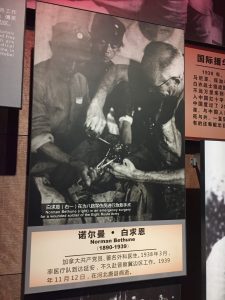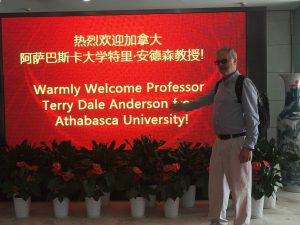Last weekend I accepted an invitation to visit and present a talk at the Jiangsu Open University in Nanjing. Nanjing is one of China’s larger cities strategically located on the Yangtze River. The Yangtze River delta was the centre of both economic power and political power for many hundreds of years and was the first capital of The Republic of China after the abdication of the last Emperor in 1912.
My host (and former PhD Student) Zhijun Wang (and her Mother and 16 month son) boarded

Zhijun Wang, Mother and son
the high speed train for the one hour trip from Wuxi. As most other travellers have noted the High speed train network in China is not only the largest, but arguably the smoothest and fastest train system in the world. We zoomed through the countryside at speeds (displayed on monitors in each car) of well over 300 KM/hour and of course we left within 1 minute of scheduled departure times.
My first “tourist” stop was to visit the Presidential palace complex where the Republic’s founding Father and first President Sun Yat-Sen and his cabinet lived and worked. The tour, through mostly empty office buildings, was a bit sparse on useful stories and the crowds (Chinese are great tourists in their own country) and heat were both a bit oppressive. Nonetheless the compound had some nice gardens and ponds and one got a sense of the optimism and pride of a people first released from autocratic rule of successive dynasties of Emperors. There was surprisingly little discussion of the civil war that shortened the life of this first republic nor the eventual triumph of the Chinese Communist Party led by Mao Tse Tung in 1949.
The next morning our host from Jiangsu took us to two adjoining museums focussed on wars ending with the Allied victory in World War Two. The first Museum of the War of Chinese People’s Resistance Against Japanese Aggression covered the global battle against fascism as expressed through aggression by Japan, Germany and Italy. The museum featured lots of photographs, equipment, maps and videos from the

Picture of Norman Bethune at work in China
extended War with, as expected, major coverage of battles that took place on Chinese soil. I of course noted the few mentions of Canadian involvement and the picture and story of Canadian Norman Bethune (pronounced in Chinese as BA-Tu-N). Everyone I have talked to here remembers memorizing Mao’s poem eulogizing Bethune that is still required study in primary classrooms throughout China. The picture below notes the official stance on China towards peace.

Peace Declaration Plaque
I am aware that China is becoming increasing proactive in global issues, not alike other countries as their wealth has increased, but China’s knows as well as any country the horrors of war and invasion.
The second Museum was dedicated to the infamous “Rape of Nanjing” in 1937 when Japanese soldiers invaded the City and went on a 30 day spree of murder, rape and theft.

Horrors of Massacre of Nanjing
Estimates place the number of dead at 300,000. The museum was fittingly quite quiet and very sobering – despite the crowd. Besides showing the effect of this assault on the people of Nanjing, the museum provided many photos, newspaper reports and stories of heroic sanctuary provided by foreigners who stayed after the Japanese began their occupation. I was pleased to see that Ontario Legislature, just this month, declared Dec 13 as the official date to honour those who suffered and died during the “Massacre of Nanjing” the first (but sadly not the last) genocide of the 20th Century.
Finally another huge lunch and we drove to the Nanjing Museum. This is 2nd largest Museum in China and we certainly did not tour all the 70,000 sq metres of displays. I mostly wanted to see the history sections – right back to dinosaurs, early copper and bronze age archeology and to full-sized rooms of Nanjing in the early 20th Century. I left the rooms full of various dynasty pottery for another day.
Later that evening I was treated to a nice banquet by the Dean of the University (who sadly spoke no more English than I speak Chinese) but through Zhijun’s translation I found a bit more about this University. Like other Open Universities in China, Jiangsu is LARGE -over 200,000 students and 8,200 staff. China’s 5 Open Universities (sadly like other Universities globally) are perceived by their campus colleagues as being inferior in terms of research and student quality (whatever that is). Entrance to China’s University system is perceived as being essential for financial success, yet only around 30% or so of students who write the dreaded 2 day Gougou entrance examinations in Grade 12 are offered a position at a campus University. Thus, the Open Universities, though still having (lower) entrance requirements, offer the only opportunity for postsecondary education for well over a million Chinese students. The main delivery model seems to be television (Jiangsu does 2 hours a day on public networks) and now increasing video delivered via Internet. Students also meet in classes with tutors once a week, but never attend a campus. Examinations are held in local learning Centers. I began to be more than just a bit concerned with the language gaps and knowing just what was expected of me in this visit and beyond.
The next morning we arrived at the University to be greeted with a big welcome sign and

Welcoming Poster at Entrance of University
with much pomp I was welcomed to the Vice President’s conference room (The President was away). After a brief (translated) chat, I was given a tour of the multiple TV studios and massive computer room and then was presented with a Certificate (and major photo op) declaring me to be a Chair Professor of Jiangsu Open University.
I then did my presentation to a crowded room – mostly about Athabasca University and a variety of innovations in Distance Education that I had been involved with at Athabasca (topic chosen by them). I was introduced by the Vice President and heard later,that she had introduced me as the ‘Norman Bethune of Distance Education’!! I think that comparison is FAR overrated as Bethune’s trip to and work in China was a world of difference from my mostly luxury trip and minor contributions here. Fortunately, again Zhijung translated from my slides for the audience. I have no idea how many of the audience could understand my English.
Of course, the lecture was video taped and transmitted to a number of their learning Centres. As normal in China, the ending prompt for questions for comments didn’t result in too much discussion, but a few interesting question. One was from a remote site and maybe mirroring some of my own concerns with video delivery, I couldn’t understand the question! Oh well.
Next, the Vice President and I were chauffeured across the street to another banquet. Finally, we talked about what they wanted from me – which turned to be “as many visits as I could manage” and some lectures. I think what they want most is association with a ‘big name’ in western distance education. They also noted they would be happy to discuss with me my requirements for expenses and “lecture fees”. Although everyone was very polite and generous with their time and compliments, I was reluctant to commit to more than I was prepared to deliver (did I mention the air quality in Nanjing – think BAD!). However, I did promise to return early next spring (hopefully with Susan). I know well how long winter can be in Edmonton.
After a send-off (with the customary envelope full of 100 RMB bills) it was back to the train station and home of Wuxi.
Terry, welcome back to Nanjing in the next early Spring with Susan. We like to know more about the community of inquiry, and hope to have a deeper discussion about that, not the rehearsal questions raised from the distance classrooms. However, remember to bring a gas mask with you to filter the air in Nanjing. Rory also had nearly the same story about his Nanjing trip in 2014 (it might be that year). Perhaps all the Canadians or foreign visitors have stories as such. The song sung many times and for good.
I have submitted proposals to the ICDE conference at Nordic. Hopefully, I can see you in there (to discuss the issues about tutors?) :-).